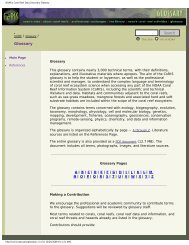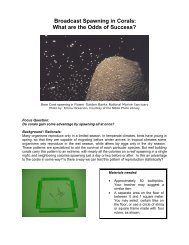Deep-Sea Coral Collection Protocols - NOAA's Coral Reef ...
Deep-Sea Coral Collection Protocols - NOAA's Coral Reef ...
Deep-Sea Coral Collection Protocols - NOAA's Coral Reef ...
- No tags were found...
Create successful ePaper yourself
Turn your PDF publications into a flip-book with our unique Google optimized e-Paper software.
Some preservation techniques for (deep water) coral samples for subsequent molecularstudies: a special supplement from Harbor Branch Oceanographic Instituteby J.V. LopezTissue Storage for Molecular Experiments: To store field collected animals for molecular biology work,it is important to store the sample such that the DNA is protected from endonucleases, which canquickly degrade the DNA once harvesting occurs. Gloves further protect samples from degradation.One option is to immediately plunge the sample into a deep freeze immediately, and in the fieldthis entails liquid nitrogen (LN2) or an ethanol/dry ice bath. Samples then can be transported in LN2dry carriers, which though convenient are expensive and must be charged after 1-2 weeks with moreLN2. At destination, most samples can be stored indefinitely in a freezer (-20 to -80oC) for subsequentDNA analyses. Alternatively, place the sample in DMSO (dimethyl sulfoxide) storage buffer, or placethe sample on a dessicant. Frost-free freezers stay frost-free by going through freeze-thaw cycles, whichis bad for DNA and RNA samples.DMSO storage buffer (Adapted from Seutin and White, 1991)20% DMSO250 mM EDTAdH 2O (to final volume)DMSO buffer is SATURATED with NaCl. In practice this means about 210g or more per liter. It takes awhile to go into solution. Make up a 0.5M EDTA (pH 8.0) solution first, then add DMSO and NaCl to halfof this, adjusting the pH to 8.0 as you go - it will help dissolution. Final pH should be 8.0. Place the samplein a wide mouthed tube (with a lid that seals water tight, such as a 15 or 50 ml conical polypropylenecentrifuge tube; this depends on the size of your tissue specimen), and add enough DMSO storage bufferto cover the sample. Samples can be transported in this solution and stored at room temp for up to 2weeks, then should be placed in a 4 o C refrigerator. These samples can then be stored for several monthsin the fridge. Dawson et al (1998) gives an excellent evaluation of various other storage techniques, butsupports the DMSO solution as the best for DNA studies.For subsequent RNA studies, using the frozen tissue protocol will often suffice, or tissue samples can beplaced in “RNALater”, specifically designed for RNA preservation when used with the manufacturer’sdirections (Ambion Inc -www.ambion.com; Austin Texas).For more details see Baker et al. 1997, France and Kocher 1996, and Lopez et al. 2002.33
















